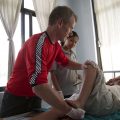Physical Therapy, also known as physiotherapy in UK, Australia and Ireland, is a division of rehabilitative medicine. Physiotherapists’ job description is to help restore function and recover or improve movement to someone infected by aging, disability, illness, injury, or caused by environmental factors, through manual therapy, movement and exercise, education and advice. They also help patients manage their pain and prevent diseases.
Physiotherapy also refers to treatments of any pain, disease or injury through physical means.
Physical Therapists or Physiotherapists, identify and know the extent of the patient’s condition and conduct therapies to improve their patient’s quality of life and potential of movement through promotion, treatment, habilitation and rehabilitation.
Habilitation refers to making an individual capable of doing something. Rehabilitation refers to making an individual capable of doing things they can no longer do properly (or perform at all), but used to do to, such as restoring their abilities to perform movements.
Promotion on the other hand, aims to help people control and improve their health.
It’s a Clinical Health Science
Physiotherapy is actually a form of alternative therapy, a clinical health science that includes medical science, namely anatomy, physiology, and neuroscience, which are all vital for understanding human’s body functions, as well as for diagnosis, prevention, treatment, rehabilitation, etc., of individuals with physical problems.
Physiotherapists work in medical environments, such as hospitals, general practice and primary care medicine practices, as well as in the community. In most countries, they must be qualified and registered by law to practice. And to become a registered physiotherapist, one must have completed a degree in physical therapy from a university or complete a health science college degree that includes a course in physical therapy.
Registered physiotherapist are experts in examining, diagnosing, and treating people with musculoskeletal, cardiothoracic, and neuromuscular disease, which focuses on conditions and problems that compromises the individual’s ability to function and move effectively.
What Do Physiotherapists Do?
As a science-based profession and someone who takes the ‘whole person’ method to health and someone’s overall well being, including the general lifestyle of their patients, physiotherapists use their knowledge, skills and training, to treat wide range of patients, and their physical problems associated with the body and its systems, including:
- Cardiovascular System – includes heart and circulatory system for medical conditions such as chronic heart disease, post heart attack rehab.
- Musculoskeletal System – concerns muscles and bones for medical conditions such as arthritis, back pain, sports related injuries, whiplash-associated disorder.
- Neuromuscular System – includes the nerves and muscles, especially the brain, spine and all the connective nerves of the body, for medical concerns like Parkinson’s disease, multiple sclerosis, and stroke.
- Respiratory System – for organs involved in breathing (i.e. lungs, throat, nose, trachea, larynx, and bronchi), for medical conditions such as asthma, cystic fibrosis, chronic obstructive pulmonary disease, etc.
The core of their treatment involves their own care, awareness, education, empowerment and participation in treatment.
Anyone can benefit from physiotherapist at any point of their life. Physical therapy is the primary treatment for some of the most common physical medical complaints, such as back pain, management of long-term medical conditions like asthma, sudden or sports-related injuries, and in preparation for a sporting event or childbirth.






 I love to write guides for those seeking a career. My books are written for everyone in an easy to read and understandable style.
I love to write guides for those seeking a career. My books are written for everyone in an easy to read and understandable style.